How many tablespoons are in a cup of butter? The answer is 16 tablespoons if you are using United States standard measurements. Download the Butter Conversion Reference Sheet and have all the conversions at your fingertips.
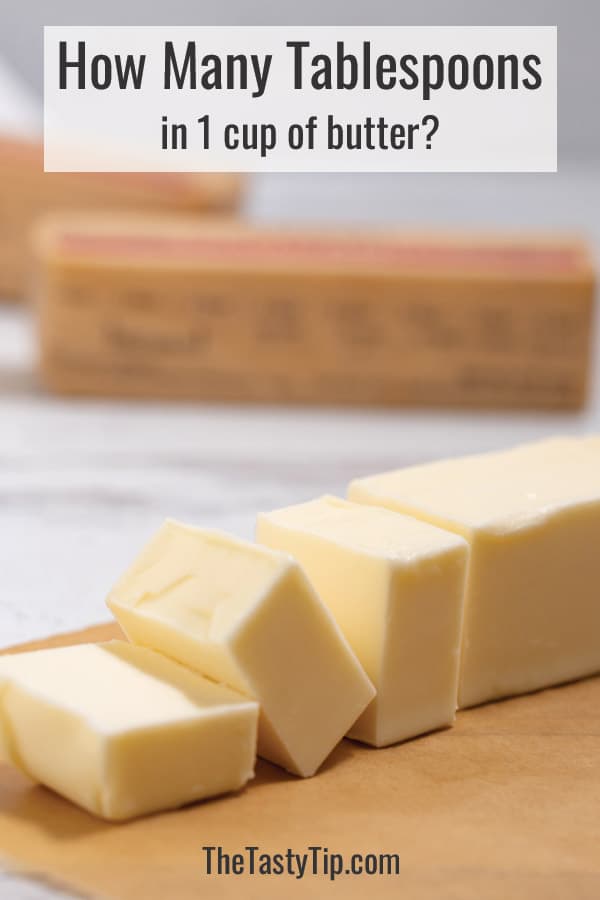
Your recipe calls for 1 cup of butter. Sounds easy enough.
But then you survey your partially used sticks of butter in the refrigerator. And you have to ask, exactly how many tablespoons are in a cup of butter.
How Many Tablespoons are in a Cup of Butter?
There are 16 tablespoons in a cup of butter, based on the US standard cup size.
Does your butter come in a tub or are you pulling together partially-used sticks of butter? Don’t worry. You can still figure out how to measure the butter to get a cup.
Download and print my handy Butter Conversion Reference Sheet. Hang it on the refrigerator and have all the common butter quantities at your fingertips.
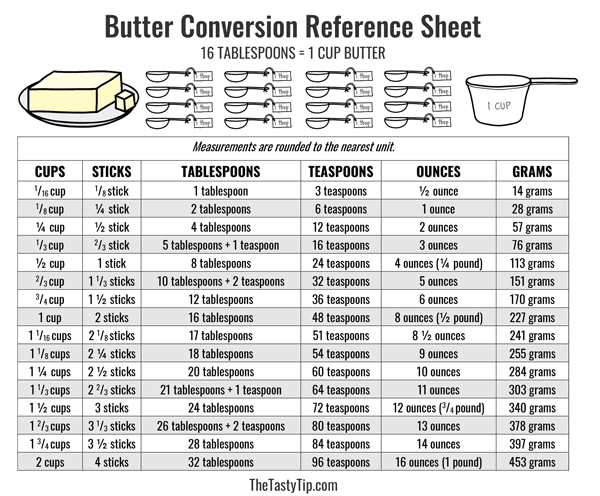
Are the Unit Measurements for Cups and Tablespoons the Same Around the World?

Unfortunately tablespoon and cup measurements differ around the world.
The United States measuring cups and spoons are not equivalent to the cup measurements used in other countries. This can lead to problems when you use a recipe from one country with the measuring equipment from a different country.
And to make things a little more tricky … the United States has a legal cup size (for nutritional labeling) and a standard cup size (for recipes).
Just to give you an idea of how cups differ around the world …
- 1 US legal cup (used in nutrition labeling) = 240 mL
- 1 US standard cup (used in recipes) = 236.588 mL
- 1 international metric cup = 250 mL
- 1 imperial cup = 284.131 mL
Thanks to The Calculator Site for that international cup information.
The volume in millilitres for the tablespoon by country are:

- United States standard tablespoon: 14.79 mL
- United States legal tablespoon: 15 mL
- United Kingdom tablespoon: 17.76 mL
- Australia tablespoon: 20 mL
It is important to know where your recipe developer lives. This determines what measurement to use if measuring by volume.
Is There a Difference Between United States Butter and European Butter
The percentage of butterfat is the main difference between butter made in the United States and butter made in Europe.
By law, butter made in the United States must be at least 80% butterfat. The standard butterfat for European butter is 82%.
In spite of these butterfat differences, you can measure either type of butter the same way.
In the United States, butter sold to consumers comes in a 1 pound package or a half pound package. And typically this butter is cut and individually wrapped into quarter pound pieces (113 grams) -- or half a cup.
Recipes may refer to butter weight (pounds, ounces, or grams) or butter volume (1 cup, ½ cup, ¼ cup, etc.). Recipes may also call for “sticks” or “cubes” of butter. Each butter “stick” (or cube) is a quarter pound equal to ½ cup.
This may be confusing to new bakers. So please download the handy reference guide which lists out how many tablespoons in a cup of butter, as well as the other common measurements you will need.
Why are Butter Sticks Different Sizes?
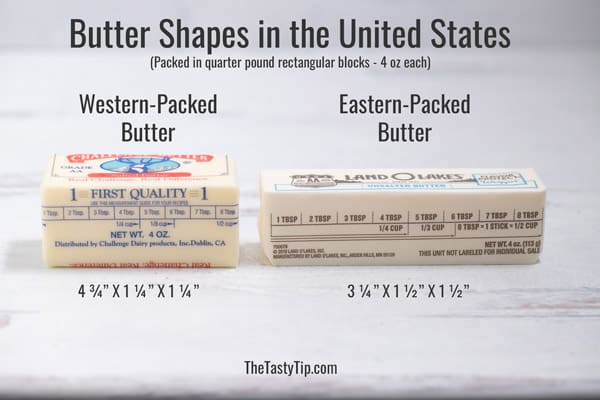
United States butter packaged east of the Rocky Mountains is usually long and narrow. The dimensions are 4 ¾” X 1 ¼” X 1 ¼”.
Butter packaged west of the Rocky Mountains is usually short and thick. The dimensions are 3 ¼” X 1 ½” X 1 ½”.
Regardless of dimensions, both butter sticks are a quarter pound or ½ cup. Each stick of butter has 8 tablespoons.
If you need 1 cup of butter, use 16 tablespoons or 2 sticks of butter.
It's All in the Package -- How Butter Wrappers Help Home Chefs
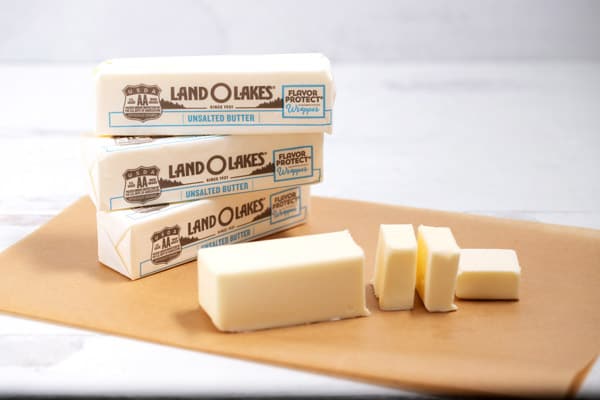
The parchment paper on each stick of butter contains tablespoon markings to make it easier to measure butter by the tablespoon. But this was not always the case.
The evolution of butter and butter packaging began in the late 1700’s. Dairy farms began churning butter, rather than relying on the surplus butter sold by individual families.
Dairy farmers brought their butter to the market in a bucket made of white oak.
But darn it, if that butter didn’t start developing a woody taste. Consumers complained about the taste, how hard it was to get out of the bucket, and the occasional appearance of mold.
Ever vigilant, butter suppliers figured out the solution. They abandoned the wooden bucket and instead wrapped the butter in paraffin (wax paper) initially. Then later switched to parchment paper.
Vegetable parchment paper saved the day. It was grease-proof, water-resistant, and prevented bad odors and tastes from reaching the butter.
Even better, parchment paper could be printed on. Great news for the butter companies. Printed logos on the butter wrapper meant constant marketing. Consumers saw the brand name every time they pulled their butter out of the refrigerator.
How is Butter Packaged + The Rise of the Quarter Pound Slabs
Up until 1907, butter was packaged and sold in solid one pound blocks.
However, the chef at the Checker and Chess Club in New Orleans asked to buy butter in quarter pound blocks. He wanted an easy way to slice off smaller amounts of butter for each table and not waste any butter.
Butter manufacturer Swift and Company complied with the request. This smaller quarter pound packaging was so well received that they decided to sell it in grocery stores.
The smaller size was so popular, it became the standard. And the rest is history.
How to Measure Butter
Butter stick wrappers often have tablespoon marks printed on the parchment paper. Convenient for the home chef. If she gets her butter packaged so the end of the butter slab exactly lines up with the first mark.
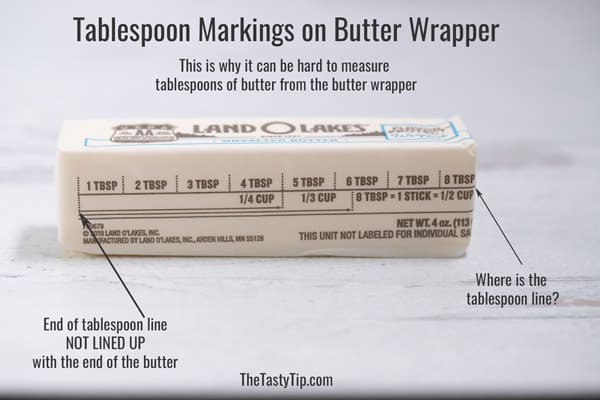
I don’t know about you, my butter is not usually lined up so conveniently. Or your butter may come in a tub or in a 1 pound piece.
So how is one supposed to measure butter?
Weigh the Butter
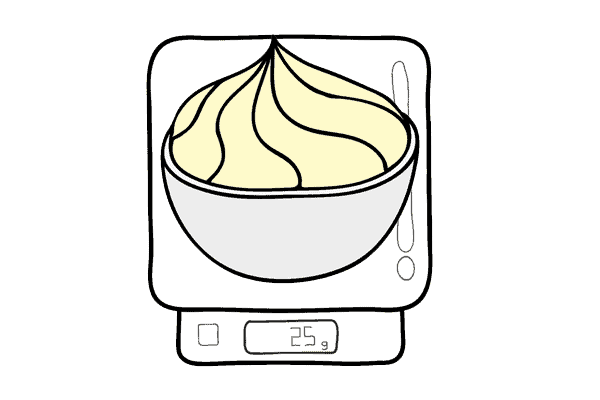
The easiest and most accurate way to measure butter for a recipe is to weigh it. All you need is a kitchen scale.
I believe every kitchen needs a scale. Your baking will improve because of your accuracy and precision and you will have less dishes to clean up.
Check out my post on how to eliminate baking disasters with a simple kitchen scale.
It is easier when the recipe gives the butter weight needed. However, if it doesn’t, you can refer to my butter conversion chart as a reference.
Use the Tablespoon Marks on the Butter Paper
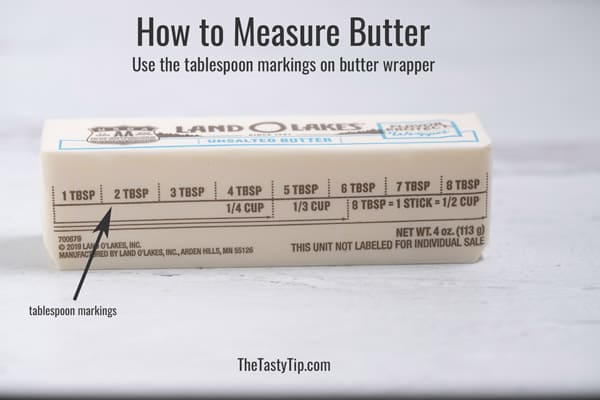
My butter is usually not lined up accurately. If your butter isn’t lined up, you can open the stick of butter and slide the butter over until it lines up.
Or don’t measure from the end.
If you only need 6 tablespoons of butter, find the first spot where the butter lines up with any tablespoon mark. Start counting the tablespoons from that spot.
You may end up cutting the butter at both ends to get an accurate measurement. That is fine.
Use a Measuring Cup
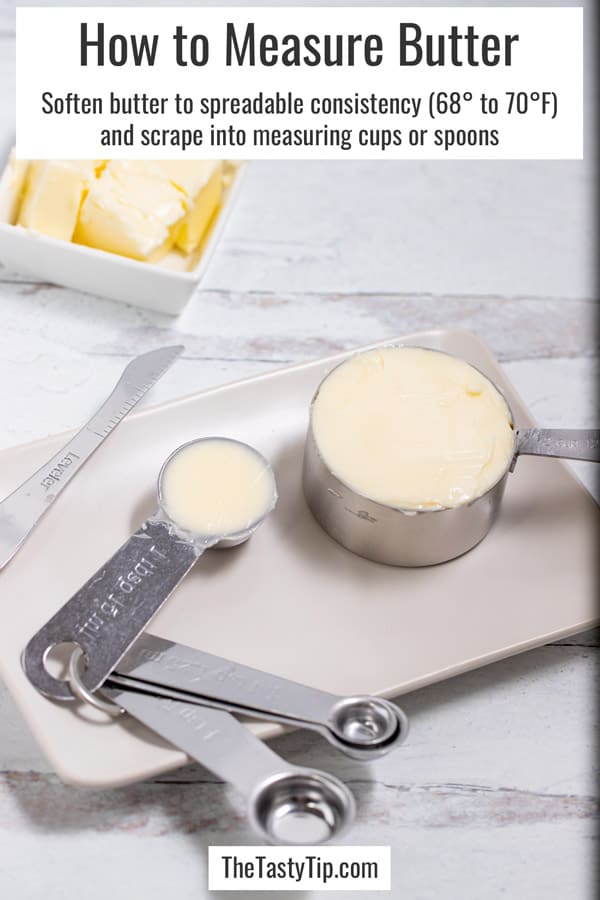
Bring the butter to soft room temperature (68° to 70°F) and use a measuring cup. The butter must be soft enough to fill the measuring cup. If it is hard, you will have empty spots in the cup and your measurement won’t be accurate.
This method can be a pain if you need your butter to be cold room temperature (60° to 65°F) for recipes like my snickerdoodle cookie recipe.
If this is the case, you will need to chill the butter after you measure it.
Use Water Displacement
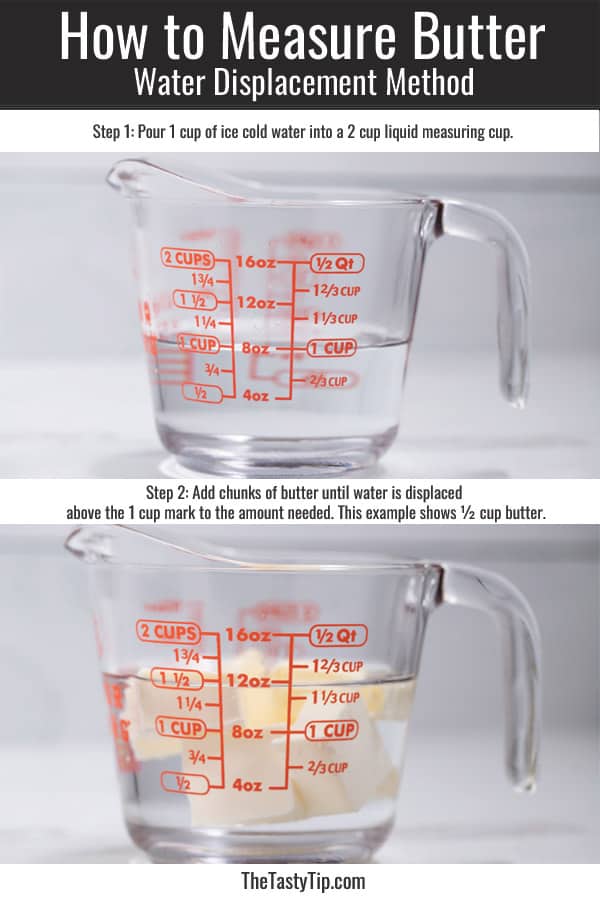
Use a liquid measuring cup that is twice the size of the amount of butter you need. If you need 1 cup of butter, use a 2 cup liquid measuring cup.
Fill the measuring cup with 1 cup of ice cold water. Add the butter in chunks until the water level reaches the amount of butter you need plus 1 cup.
For example, if you need ½ cup of butter, fill the measuring cup with 1 cup of ice cold water. Add cold butter chunks until the water level reaches 1 ½ cup.
Remove the butter from the water and pat the butter dry.
This method is scientifically accurate and based on the Archimedes principle, a law of physics.
How Will You Measure Butter?
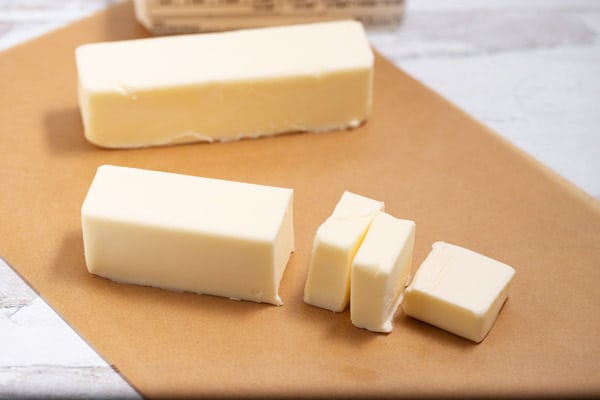
As you can see, weighing is, by far, the easiest method if you have a kitchen scale and know the weight of butter needed for your recipe.
But if you don’t have a kitchen scale, knowing how many tablespoons are in a cup of butter can help you figure out any amount of butter you need.
Now that you have all the information you need to measure butter accurately, let’s get baking.
Did you like this post? Then let's be social. FOLLOW ME on PINTEREST and INSTAGRAM to keep up with the latest tutorials, favorite recipes and interesting happenings.
Need more conversion measurements? Check out my other posts. They all have a conversion download chart for your convenience.

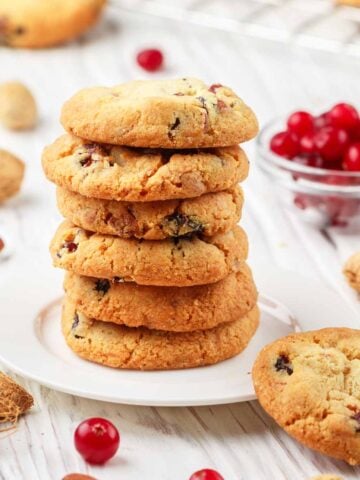
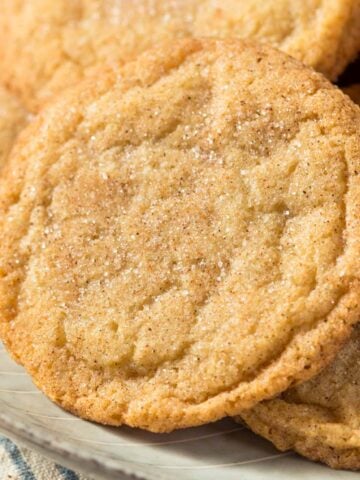
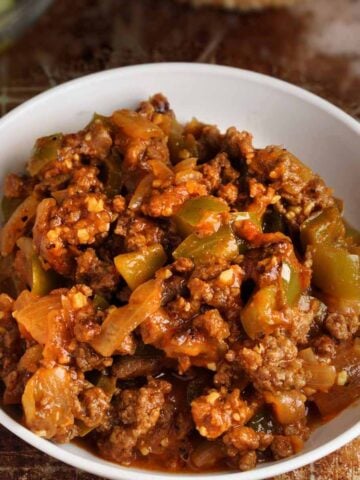
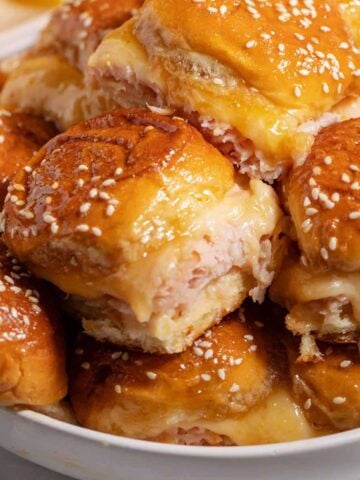
Comments
No Comments